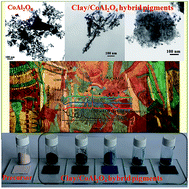Abstract: Clay/CoAl2O4 hybrid pigments with different morphologies and colors have been successfully fabricated by combining the coprecipitation technique and a successive calcination step. The morphologies of the obtained hybrid pigments are dependent on the morphologies of the inorganic clays, whereas the colors of the hybrid pigments are largely determined by the successive calcination temperature. The results reveal that the incorporation of the two-dimensional illite-smectite mixed-layer clay is favorable for the protection of the morphologies of the hybrid pigments from the calcination temperature compared with that of one-dimensional attapulgite. The color of the hybrid pigments changes from atrovirens to blue to dark blue with increasing calcination temperature from 800 degrees C to 1000 degrees C to 1200 degrees C, which is similar to the famous "Maya blue" pigment. It can be noted that the introduction of the inorganic clays not only decreases the production cost, but also prevents aggregation and an increase in the size of CoAl2O4 nanoparticles. There is no doubt that this strategy can realize the widespread application of CoAl2O4 pigments in the relevant fields. KeyWords Plus: CERAMIC PIGMENTS; SOL-GEL; COAL2O4; BLUE; PARTICLES; DECOMPOSITION Published in RSC ADVANCES, 5 (124):102674-102681; 10.1039/c5ra19955g 2015 
|

